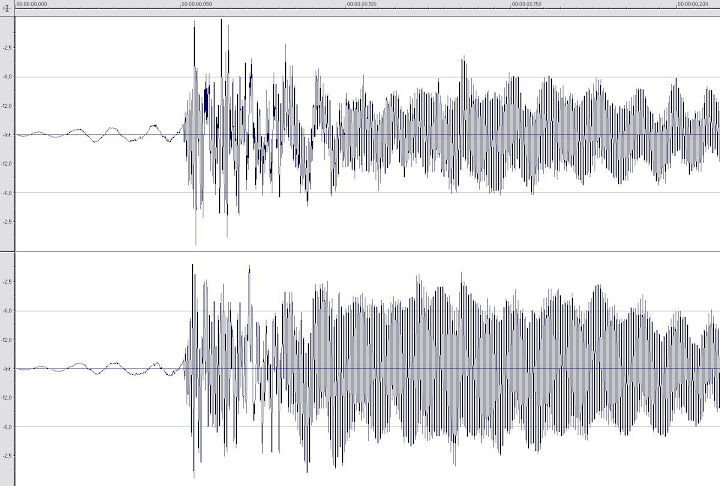joshuasethcomposer wrote:.... I believe "hammer noise" should include the noise the hammers make as they whip through the air. The harder you strike the keys, the more prominent that sound. I'm sure you know what I'm talking about--that acute, subtle whoosh of air you hear at the very beginning of hard strikes on a real piano. Sampled pianos capture this essential element of the experience. You should, too!
Hello Joshua,
I just encountered this thread in the forum and have not read all of the replies, but would like to discuss the notion of "whooshing air" that you describe, as hammers approach the strings.
I strongly suspect the sound you hear is not due to air turbulence caused by hammers. Why not? the hammer head has to accelerate from a standing start through a distance of no more than about 2-3 inches, in the time of approximately one-fifth to one-tenth of a second. Even if the acceleration was nearly instantaneous, we are only talking of about a terminal velocity of 30 inches per second (3" divided by 0.1 seconds).
If you realize that 60 mph is a mile in a minute, or 5280 feet in 60 seconds, or 88 feet in one second, then consider that 2-1/2 feet per second is only about 3 miles per hour -- hardly enough speed to cause air turbulence -- especially in something with as small a cross section as the leading edge of a piano hammer. So the average velocity is 30" per second, and from a standing start, the final speed at impact might only be 5 to 10 miles per hour -- there is neither enough time, nor distance, nor surface area to cause a whooshing sound.
More to the point, please note that if you swing your arm through the air as fast as you can, even with fingers outstretched, you are moving far more air than would be moved by the above mentioned hammers. Do you hear whooshing sounds when you wave your arms with fingers outstretched (to move the maximum amount of air possible)? The obvious answer is 'No'. In the case of the swinging arm, a major league baseball player can accelerate his hand from 0 to over 90 mph in approximately 1/3rd of a second -- but there is no whoosh from air turbulence from even a professional major league baseball players arm or hand.
On the other hand, when Tiger Woods swings a golf club (or his wife swings one into his face), the whoosh you hear is NOT due to the air, per se, but rather to the resonance of the flexing golf club shank as it slices through the air.
So, what are we hearing instead? Many times, grand pianos emit whooshing sounds (actually I prefer to call it a "hissing" sound) when the sustain pedal is depressed, and the dampers collectively leave the strings at the same time. This occurs when the dampers are slightly misaligned when they rest on the string after the previous time they were lifted (by depressing a given note or hitting the sustain pedal). When they are lifted by the sustain pedal, the slight misalignment can tend to excite the higher harmonics inherent in all strings, but especially of the low and midrange strings.
Now that particular hissing sound can be emulated in Pianoteq by increasing the sustain pedal noise and hammer noise.
I hope this clarified what you were experiencing.
Cheers,
Joe
Last edited by jcfelice88keys (05-12-2009 10:23)

